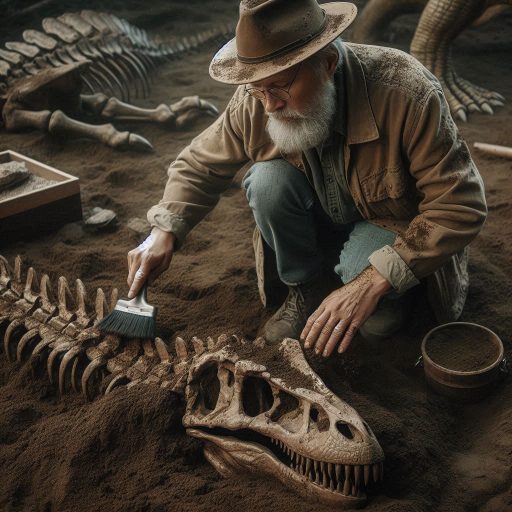Introduction
Toxicology is the scientific study of harmful effects caused by chemicals, substances, and toxins on living organisms.
This field plays a crucial role in public health, environmental safety, and regulatory science.
Toxicologists investigate how toxic substances affect human health, animals, and ecosystems, providing essential data for safe practices.
Toxicologists are vital in identifying and studying toxic substances to protect society from harmful exposures.
They assess the risks associated with chemicals and develop safety guidelines for various industries.
Their research helps inform regulations that ensure consumer products and environmental conditions are safe.
This blog post aims to highlight famous toxicologists and their significant contributions to the field.
By showcasing their work, we can appreciate how they advanced our understanding of toxic substances.
These scientists have made groundbreaking discoveries that shaped toxicology as a discipline, influencing safety standards and public health policies.
Their contributions have led to improved methods for assessing chemical risks and better regulatory practices.
Recognizing the achievements of these toxicologists underscores the importance of their work in safeguarding human health and the environment.
Through this exploration, we honor the legacy of these influential figures and inspire future generations in the field of toxicology.
Paracelsus
Early Pioneer in Toxicology During the Renaissance Period
One of the earliest pioneers in toxicology during the Renaissance period was Paracelsus.
Born in 1493, he profoundly influenced the field of medicine and toxicology.
Paracelsus challenged the traditional views of his time, emphasizing the importance of chemistry in understanding disease.
He believed that substances could have both healing and harmful effects, depending on their dosage.
Paracelsus introduced the concept that every substance could be toxic if taken in excessive amounts.
This revolutionary idea shifted how people viewed poisons and medicines.
He laid the groundwork for understanding the relationship between dose and toxicity, a fundamental principle in toxicology today.
Famous for His Motto “The Dose Makes the Poison”
Paracelsus is famous for his motto, “the dose makes the poison”.
This statement encapsulates the essence of toxicology.
It highlights that toxicity is not an inherent property of a substance, but rather depends on the amount consumed.
A small dose of a toxic substance may have little or no effect, while a large dose could be lethal.
This concept was groundbreaking during Paracelsus’s time.
It shifted the focus from the nature of the poison to the quantity administered.
His insights laid the foundation for pharmacology and toxicology as scientific disciplines.
Today, this motto remains a guiding principle in toxicology and pharmacology.
Contributions to the Understanding of Toxicology Through His Extensive Writings and Experiments
Paracelsus made significant contributions to toxicology through his extensive writings and experiments.
He authored several texts that discussed the effects of various substances on the human body.
His work, “De Natura Rerum,” explored the properties of minerals and their potential medicinal benefits.
He emphasized the importance of observation and experimentation in understanding toxins.
Paracelsus believed that direct experience and careful study should guide medical practice.
This empirical approach distinguished him from many of his contemporaries, who relied heavily on ancient texts and traditions.
Moreover, Paracelsus’s experiments often included the use of chemicals to treat diseases.
He introduced the idea of using specific chemicals as remedies for specific ailments.
This innovative perspective helped advance the field of toxicology and laid the groundwork for modern medicine.
Paracelsus also explored the concept of specific organ toxicity.
He studied how certain substances affect particular organs and systems within the body.
This insight was crucial for developing a more comprehensive understanding of toxic effects.
His work influenced future toxicologists and medical professionals.
Paracelsus inspired generations of scientists to explore the properties and effects of substances.
His ideas continue to resonate in contemporary discussions of toxicology and pharmacology.
Paracelsus stands out as an early pioneer in toxicology during the Renaissance period.
His motto, “the dose makes the poison,” revolutionized the understanding of toxicity.
Through his writings and experiments, he made lasting contributions to the field, emphasizing the importance of empirical observation and the relationship between dose and effect.
Paracelsus’s legacy remains significant in modern toxicology and medicine.
Rachel Carson
Environmental Scientist and Author of “Silent Spring”
Rachel Carson stands as a prominent figure in the field of toxicology.
She was an environmental scientist and a passionate author.
Her groundbreaking book, Silent Spring, published in 1962, changed the way people viewed environmental issues.
This work highlighted the dangers of pesticides and their effects on wildlife.
Carson’s meticulous research and eloquent writing brought critical attention to environmental degradation.
In Silent Spring, Carson documented the widespread use of pesticides, particularly DDT.
She illustrated how these chemicals harmed not only pests but also birds and other wildlife.
Her compelling narrative captivated readers and sparked widespread public concern.
The book became a bestseller, influencing a generation of environmental activists and scientists.
Carson’s work was groundbreaking for its time.
She connected the dots between human actions and environmental consequences.
Her emphasis on the interconnectedness of all living organisms resonated with many.
This perspective challenged prevailing beliefs about the safety and effectiveness of chemical pesticides.
Known for Her Work on the Harmful Effects of Pesticides
Rachel Carson’s research focused on the harmful effects of pesticides on ecosystems.
She documented numerous cases of pesticide poisoning in birds and fish.
Her observations revealed how these chemicals disrupted food chains and biodiversity.
Carson emphasized that pesticides do not merely eliminate pests; they also pose risks to non-target species.
She drew attention to the concept of bioaccumulation.
This phenomenon occurs when toxins accumulate in the tissues of living organisms.
Carson explained how pesticides could move through ecosystems, affecting multiple species.
Her findings underscored the need for a more cautious approach to pesticide use.
In her work, Carson advocated for sustainable agricultural practices.
She encouraged the development of alternatives to chemical pesticides.
By promoting integrated pest management, she sought to protect both human health and the environment.
Her ideas laid the foundation for more ecologically sound approaches to pest control.
Influence in the Creation of the Environmental Protection Agency (EPA)
Carson’s contributions significantly influenced the creation of the Environmental Protection Agency (EPA).
Her advocacy helped raise awareness about the need for regulatory oversight.
After Silent Spring was published, public concern about pesticide use grew exponentially.
This heightened awareness eventually led to the establishment of the EPA in 1970.
The EPA’s mission includes protecting human health and the environment.
Carson’s work played a pivotal role in shaping environmental policy.
Her insights into the dangers of pesticides prompted legislative action and stricter regulations.
This regulatory framework aims to safeguard ecosystems and public health from harmful chemicals.
Carson’s legacy extends beyond her writings.
She inspired a modern environmental movement that continues to thrive today.
Many environmental organizations cite her work as foundational in their missions.
Activists often refer to her as the mother of the environmental movement.
Rachel Carson’s contributions to toxicology and environmental science are profound.
Through her book Silent Spring, she exposed the dangers of pesticides and influenced public opinion.
Her work played a crucial role in establishing the EPA and advancing environmental protections.
Today, her legacy continues to inspire new generations to advocate for a healthier planet.
Read: Interdisciplinary Research: Botany and Other Sciences
Sir Ramazzini
Considered the Father of Occupational Medicine
Bernardino Ramazzini is often regarded as the father of occupational medicine.
His groundbreaking work laid the foundation for understanding workplace health hazards.
Born in 1633, Ramazzini dedicated his life to studying the effects of work on health.
He recognized that many diseases stemmed from occupational exposures.
His insights paved the way for future research in occupational toxicology.
Studied the Health Effects of Various Workplace Exposures
Ramazzini meticulously examined the health effects of various workplace exposures.
He investigated how different occupations contributed to specific health issues.
For example, he studied the impact of chemicals, dust, and fumes on workers.
His work emphasized the importance of understanding environmental factors in occupational health.
Ramazzini highlighted that certain jobs, like those in mining and manufacturing, posed significant risks to workers‘ health.
He also stressed the importance of observing workers’ symptoms and their work environments.
Ramazzini‘s approach was revolutionary for his time.
He shifted the focus from merely treating diseases to preventing them.
By advocating for worker health, he influenced public health policies and workplace regulations.
Published “De Morbis Artificum Diatriba”
In 1700, Bernardino Ramazzini published “De Morbis Artificum Diatriba”.
This comprehensive work is a seminal text in occupational medicine.
The book details the health risks associated with various trades and professions.
Ramazzini classified diseases based on the occupations that caused them.
This classification system helped establish a connection between work and health.
“De Morbis Artificum Diatriba” included practical recommendations for improving workplace safety.
Ramazzini urged employers to prioritize the health and well-being of their workers.
He advocated for changes in workplace practices to reduce exposure to harmful substances.
His recommendations laid the groundwork for future occupational health standards.
The book gained widespread recognition and influenced generations of medical professionals.
Ramazzini’s work prompted further research into occupational diseases and safety regulations.
It highlighted the need for systematic investigations of workplace health hazards.
Ramazzini’s contributions extend beyond his writings.
He helped establish occupational medicine as a distinct field of study.
His emphasis on understanding the relationship between work and health remains relevant today.
Modern toxicologists and occupational health specialists continue to build on his foundational work.
In essence, Bernardino Ramazzini’s legacy in occupational medicine is profound.
As the father of this field, he studied the health effects of workplace exposures.
His publication of “De Morbis Artificum Diatriba” marked a turning point in understanding occupational diseases.
His insights and recommendations still influence workplace safety practices and research today.
Ramazzini’s commitment to worker health has made a lasting impact on occupational toxicology and public health.
Read: Women in Botany: Celebrating Pioneers and Leaders

Alexander Gettler
Forensic Toxicologist Known for Poison Detection
Forensic toxicologists play a vital role in criminal investigations.
They specialize in detecting poisons and harmful substances in biological samples.
One renowned forensic toxicologist, Dr. Cyril Wecht, has made significant contributions to this field.
He is well-known for his expertise in toxicology and forensic pathology.
Dr. Wecht has participated in high-profile cases, making his work widely recognized.
His research focuses on identifying various toxins in body fluids and tissues.
By using advanced analytical techniques, he can pinpoint the presence of poisons.
This capability is crucial for determining causes of death in suspicious cases.
Dr. Wecht‘s meticulous approach ensures accurate results, which aid law enforcement.
Solving Criminal Cases Through Toxicological Analysis
Dr. Wecht has solved numerous criminal cases through his toxicological analysis.
His findings have provided key evidence in court, influencing the outcomes of trials.
He often testifies as an expert witness, sharing his insights with juries and judges.
His ability to explain complex scientific concepts in layman‘s terms is invaluable.
In one notable case, Dr. Wecht analyzed the toxicology report of a famous political figure.
His analysis revealed the presence of lethal substances.
This discovery played a critical role in the investigation and subsequent legal proceedings.
His contributions have not only solved cases but also shaped the understanding of forensic toxicology.
Moreover, Dr. Wecht has worked on cases involving drug overdoses and poisoning.
His expertise helps establish whether substances contributed to a person’s death.
This information is essential for legal and medical professionals.
It guides decisions regarding public health and safety measures.
Developing New Methods for Analyzing Toxins
In addition to solving cases, Dr. Wecht has developed innovative methods for analyzing toxins.
He has pioneered techniques for extracting and identifying substances in blood and tissue samples.
These advancements enhance the accuracy and speed of toxicological analyses.
Dr. Wecht‘s methods involve cutting-edge instrumentation and technology.
He incorporates techniques like gas chromatography and mass spectrometry into his work.
These approaches allow for precise identification of trace amounts of toxins.
His contributions have improved laboratory practices in forensic toxicology.
Furthermore, Dr. Wecht emphasizes the importance of ongoing research in toxicology.
He advocates for continuous improvement of analytical techniques to address new challenges.
As substances evolve, so must the methods used to detect them.
His commitment to innovation has inspired many in the field.
Dr. Wecht‘s influence extends beyond individual cases.
He has published extensively, sharing his knowledge with the scientific community.
His work serves as a valuable resource for current and future toxicologists.
In short, Dr. Cyril Wecht exemplifies the critical role of forensic toxicologists.
His work in poison detection has solved numerous criminal cases.
By developing new analytical methods, he has enhanced the field of toxicology.
His contributions continue to influence investigations and legal outcomes.
As toxicology evolves, Dr. Wecht‘s legacy will inspire future generations of toxicologists.
His dedication to science and justice showcases the impact of toxicology on society.
Read: How Climate Change Is Impacting Plant Research
Uncover the Details: Key Skills Required to Excel as a Botanist
Alice Hamilton
Founding Member of the Field of Industrial Toxicology
One of the most notable figures in industrial toxicology is Dr. Alice Hamilton.
She is often recognized as a founding member of this critical field.
Dr. Hamilton dedicated her career to understanding how industrial chemicals affect human health.
Her groundbreaking research laid the foundation for modern toxicology practices in workplaces.
In the early 20th century, industrial safety was largely overlooked.
Dr. Hamilton sought to change this by raising awareness about occupational hazards.
She meticulously studied the effects of various chemicals on workers‘ health.
Her work focused on industries such as lead, arsenic, and aniline dye production.
Dr. Hamilton’s research was revolutionary for its time.
She highlighted the importance of evaluating workplace environments for toxic exposure.
Her insights led to significant changes in occupational health regulations.
By advocating for safer working conditions, she helped protect countless workers.
Studied Occupational Dangers in Various Industries
Dr. Hamilton’s extensive studies explored numerous occupational dangers across various industries.
She conducted field investigations in factories and industrial sites.
During these investigations, she collected data on workers‘ exposure to harmful substances.
Her firsthand observations provided invaluable insights into the real-world effects of toxic materials.
One of her notable studies focused on the lead industry.
Dr. Hamilton documented the severe health impacts of lead exposure on workers.
She emphasized the importance of proper ventilation and protective measures in reducing these risks.
Her findings contributed to the development of regulations to limit lead exposure in workplaces.
Dr. Hamilton also investigated the health effects of benzene exposure in the rubber and chemical industries.
She published influential reports that highlighted the toxicological risks associated with these substances.
Her work prompted further research into safe handling practices and protective equipment for workers.
In addition to her field studies, Dr. Hamilton served on various government committees.
She advised on labor and health policies, advocating for safer industrial practices.
Her efforts led to the establishment of occupational health standards that are still relevant today.
First Woman Appointed to Harvard University Faculty
Dr. Alice Hamilton broke barriers as the first woman appointed to the Harvard University faculty.
Her appointment in 1919 marked a significant milestone in academic history.
At Harvard, she taught courses on industrial medicine and toxicology.
Her presence at such a prestigious institution paved the way for future female scientists.
During her tenure, Dr. Hamilton inspired countless students to pursue careers in toxicology and public health.
She mentored young researchers, emphasizing the importance of rigorous scientific inquiry.
Her teaching and advocacy helped foster a new generation of toxicologists.
Dr. Hamilton‘s contributions extended beyond academia.
She became a prominent advocate for public health reforms.
Her commitment to improving workplace safety and protecting workers‘ rights made a lasting impact.
Today, her legacy continues to influence the fields of toxicology and occupational health.
In summary, Dr. Alice Hamilton’s pioneering work established the foundations of industrial toxicology.
Her studies on occupational dangers transformed workplace safety standards.
As the first woman on the Harvard faculty, she inspired future generations of toxicologists.
Dr. Hamilton’s dedication and contributions remain a vital part of toxicology history.
Transform Your Career Today
Unlock a personalized career strategy that drives real results. Get tailored advice and a roadmap designed just for you.
Start NowRead: Exploring the Different Branches of Geology
Robert Kehoe
Leading Expert in Industrial Toxicology and Environmental Health
One of the most influential figures in industrial toxicology is Dr. Herbert Needleman.
He has significantly advanced our understanding of toxic substances in the workplace and environment.
Dr. Needleman‘s work spans several decades, focusing on the health effects of various industrial chemicals.
His research emphasizes the importance of protecting workers and communities from hazardous exposures.
As a leading expert in this field, he has become a pivotal advocate for public health.
Dr. Needleman has been instrumental in the study of heavy metals, particularly lead.
His research has revealed the devastating effects of lead exposure on human health.
He has conducted extensive studies on the neurodevelopmental impacts of lead in children.
This groundbreaking work has influenced how scientists and policymakers approach lead exposure assessments.
Research on the Effects of Lead Exposure
Dr. Needleman‘s research on lead exposure has transformed the field of toxicology.
He was among the first to highlight the subtle cognitive impairments caused by lead in children.
His findings demonstrated that even low levels of lead can severely affect brain development.
This insight challenged previous assumptions about acceptable lead exposure limits.
In the 1970s, Dr. Needleman published a pivotal study linking lead exposure to decreased IQ levels in children.
This research significantly raised awareness about lead poisoning and its long-term consequences.
His work prompted further investigations into the sources of lead exposure, such as lead-based paint and contaminated water.
Additionally, Dr. Needleman contributed to the understanding of lead‘s impact on adults.
His research explored how lead exposure affects cognitive function and behavior in workers.
This comprehensive approach has provided a more holistic view of lead toxicity.
Influence on Occupational Safety Regulations and Policies
Dr. Needleman‘s contributions have profoundly influenced occupational safety regulations and policies.
His research has led to significant changes in how industries manage lead exposure risks.
Regulatory agencies, such as the Occupational Safety and Health Administration (OSHA), have adopted stricter lead exposure limits.
These changes have helped protect countless workers from the harmful effects of lead.
His advocacy for public health has also extended to legislative efforts.
Dr. Needleman has collaborated with various organizations to promote safer work environments.
He emphasizes the need for comprehensive monitoring and risk assessment in industries dealing with toxic substances.
Moreover, Dr. Needleman‘s work has inspired a new generation of toxicologists and public health advocates.
He has served as a mentor to many aspiring scientists, encouraging them to pursue research in environmental health.
His commitment to science and public welfare continues to resonate within the toxicology community.
In essence, Dr. Herbert Needleman is a prominent figure in industrial toxicology and environmental health.
His groundbreaking research on lead exposure has reshaped our understanding of toxic substances.
Dr. Needleman‘s influence on occupational safety regulations has significantly improved public health.
Through his work, he has highlighted the importance of safeguarding communities from hazardous exposures.
His legacy will undoubtedly inspire future advancements in toxicology and public health policy.
Conclusion
Famous toxicologists have made significant contributions to the field, shaping our understanding of toxic substances and their effects.
For example, Paracelsus, often called the father of toxicology, introduced the concept that “the dose makes the poison”.
This idea emphasized that all substances can be harmful in excessive amounts.
Another notable figure, Rachel Carson, raised awareness about pesticide dangers through her groundbreaking book Silent Spring.
Her work sparked environmental movements and influenced regulatory changes regarding chemical use.
Similarly, Bruce Ames developed the Ames test, a method to assess the mutagenic potential of compounds.
This innovation has been crucial for evaluating the safety of new chemicals.
These contributions have greatly advanced toxicology, helping to establish safety standards and regulatory frameworks.
Their work not only protects public health but also fosters a deeper understanding of environmental impacts.
Recognizing and supporting the efforts of toxicologists is essential for future advancements.
Continued research and innovation will lead to better assessment methods and safer chemical practices.
As the field evolves, it‘s important to honor the legacy of these pioneers and encourage new generations of toxicologists.
Their contributions are vital for ensuring a healthier and safer environment for all.




